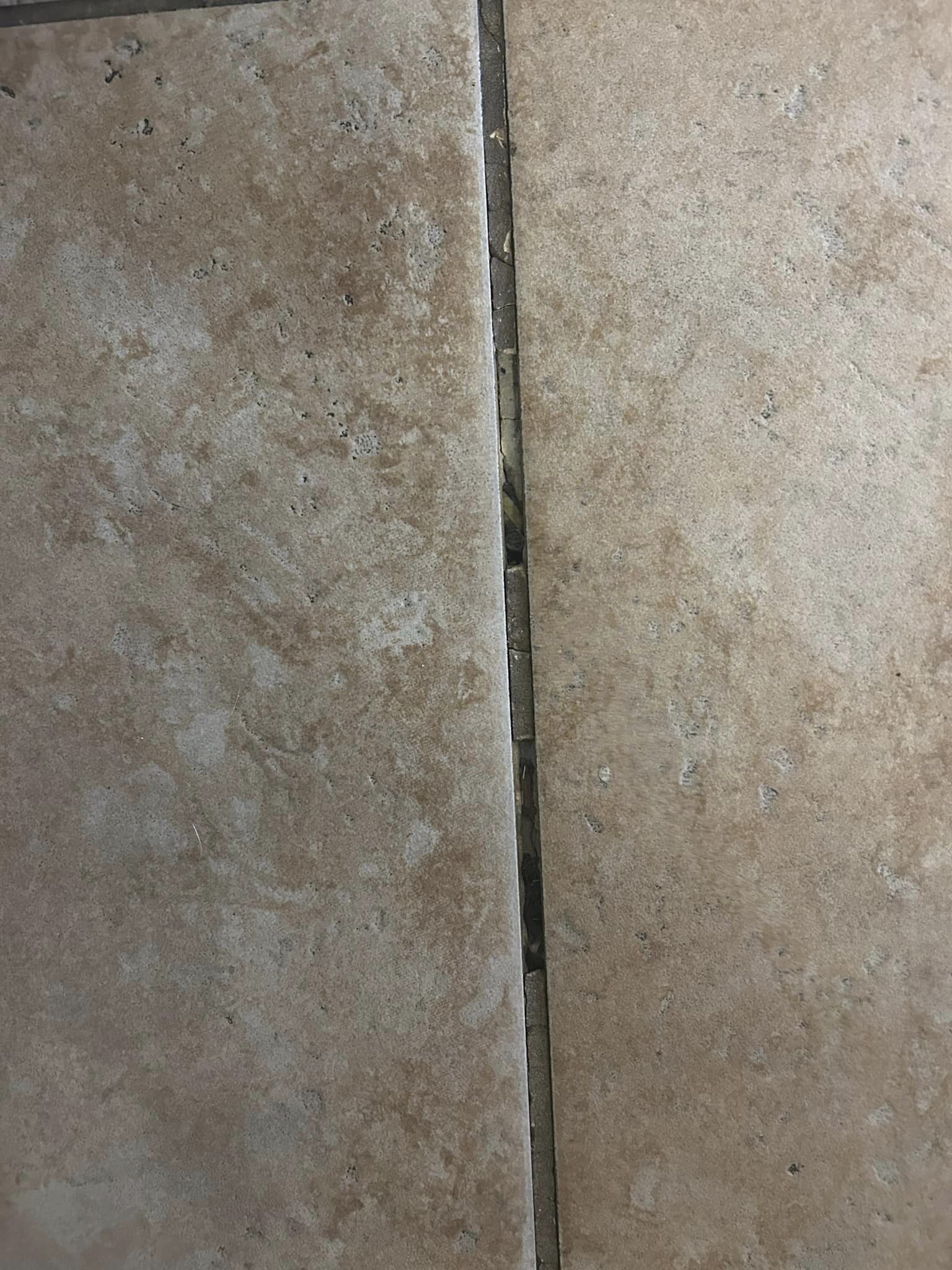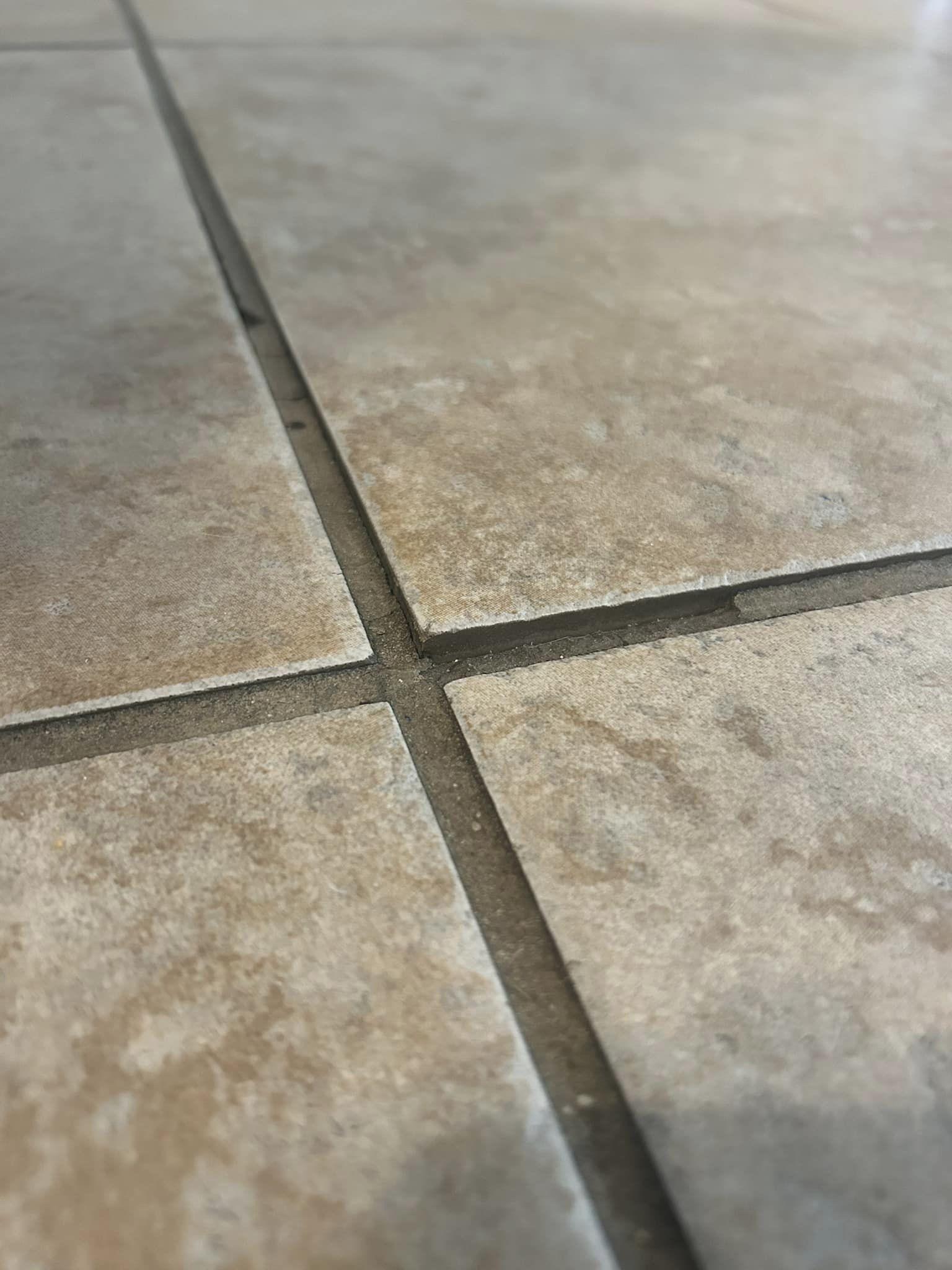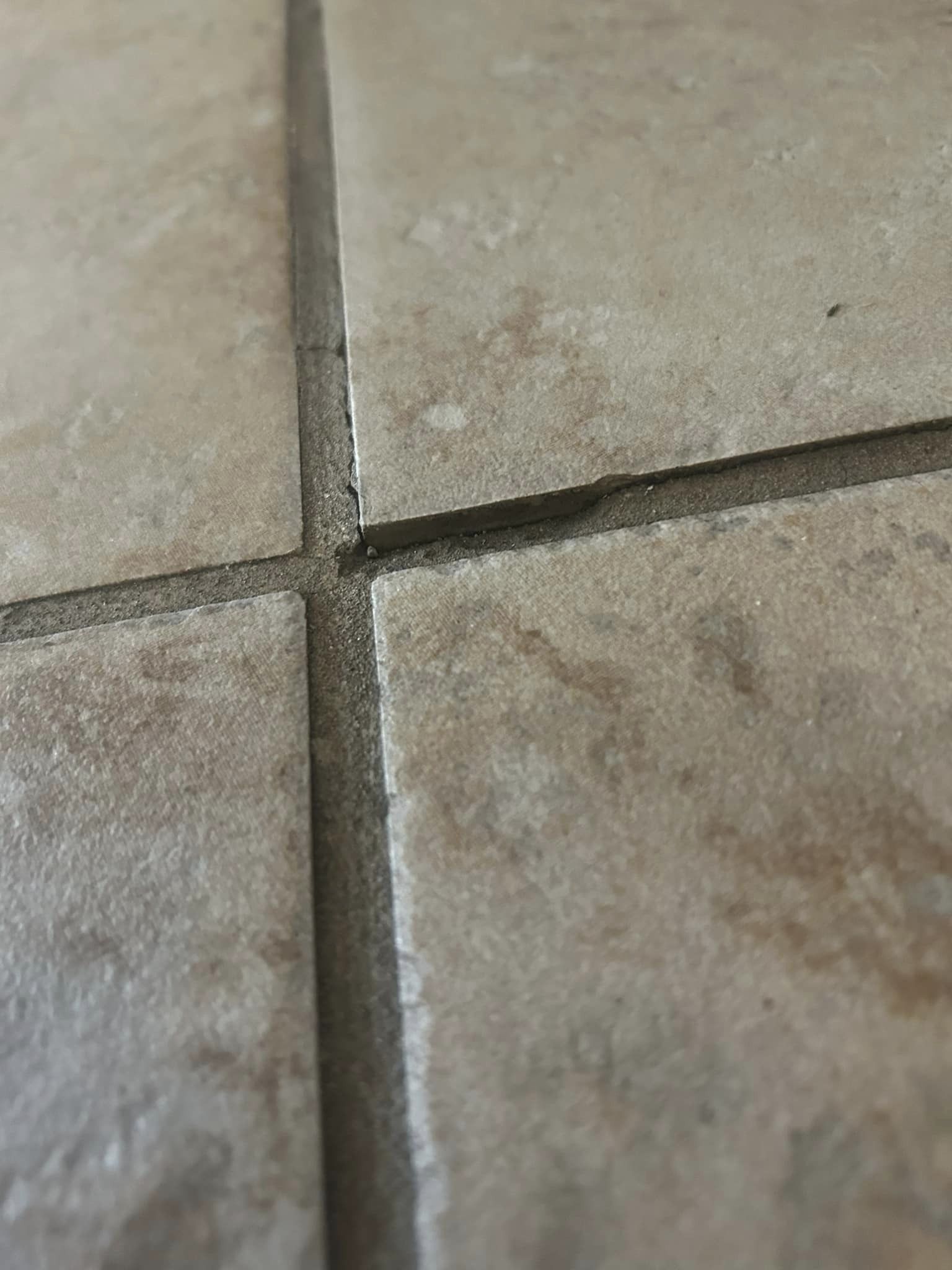Is it worth repairing broken tiles and grout or should we install LVP over existing tile to save time, money, and mess on a concrete slab subfloor?
Hey there! So, we’re gearing up to put in LVP flooring throughout our whole house, which is currently covered in tile. The plan is to rip out all the tile, level out any uneven spots, and then lay down the LVP. I’m bracing myself for the mess and hard work that comes with removing all that tile – we’re talking about 1100 square feet here.
Now, my dad, who’s a pro at laying down floors (seriously, he’s done it in every place we’ve lived), thinks we could just install the LVP right over the tile. I’ve seen some folks do this and watched a few videos, but I’m not entirely convinced it’s the best route. Some of the tiles are starting to pop up and there are cracked grout lines in places. So, here’s the big question: would it be worth it to fix up those broken tiles and grout, then lay the LVP over the tile to save time, money, and a whole lot of mess? And if so, how would we go about that process?
Dad’s suggesting we just slap down the underlayment and then the LVP, but I feel like we might need to add a



Rely on your Dad. Install the LVP directly on top of that tile. Use floor leveling compound to fill in any noticeable low or high spots.
Think you might do well. Only main concerns I have are spot leveling, which is manageable, and any baseboards might need to be raised.
If you opt for an LVP with a good quality underlayment, chances are you’ll be in good shape.
Using a thick underlayment could lead to the seams cracking.
You can lay the vinyl over the tile with no issues. Just make sure to level any low spots and fill the grout lines with self-leveling material to create a smooth floor. Then, put down a 6 mil plastic sheet and install the flooring right on top with the pre-attached pad.
I was thinking of doing that too, but with such a large grout joint, I think it’s best to float the entire floor with leveler. That way, the tile pattern won’t wear through the LVP. The LVP is 1/2″ thick, which might help, but why risk it?
Installing LVP is a breeze as long as the surface is nice and level.
We recently installed new flooring over our tile and it turned out great.
Wow, ! That looks fantastic. Appreciate you sharing.
Thanks a lot- this was back when we purchased the house
Ugh, that tile looks identical to mine 🤢 and I can’t stand it!
Oh yeah, I totally understand. It was much more affordable to just lay vinyl plank over it.
I personally think laminate flooring would be a better choice over tile than LVP. It’s more forgiving and feels softer underfoot.
Do you really believe laminate is softer than vinyl?!? I think you might be mistaken, buddy
Vinyl is thin and plastic while laminate is made of compressed wood and allows for a thicker underlay to be laid down. Maybe there was a bit of confusion there on your end.
Hey , the luxury vinyl planks I bought are surprisingly not thin. In fact, they’re thicker than many of the laminate options I looked at. They’re 12mm thick in total, including the rubber pad and rigid core.
Oops, I was actually meant to reply to !
Hey , I’ve never seen a product that thick before. I’d consider using some self-leveler to fill in the tile seams. If your joints line up in those cracks, your vinyl joints will crack too.
Sounds good, . That’s the idea! 👍🏻
I had the flooring put in over my kitchen tile. It wasn’t a huge area but it definitely saved me some time and money. The installer assured me it would be fine. Everything’s still looking good over a year, maybe two later.
If you want to save time, take out the baseboards and trim the door for a more polished finish.
Absolutely, I’m planning on doing the same. I’ll be replacing all the baseboards and trim as well.
Thank you to everyone! It seems like I’ll be installing the new flooring over the existing tile, which is a relief because I really didn’t want to deal with the mess of removing all that tile. How should I go about repairing the broken tiles before applying self-leveler? They feel loose and make a popping sound when stepped on.
Hey , I’ve removed them in a previous house by scraping it all up and installing replacement tiles.
Hey , if the broken tiles will affect the installation (you can test it by installing over the affected area, using a whole box and then walking on it), you can pour leveler directly over the tile. It’s best to pour leveler over the tile, but not absolutely necessary if the broken tile doesn’t affect the flooring.
Hey, , don’t forget to clear away any broken pieces, vacuum, and grab a small bag of self-leveling concrete.
If there’s anything loose, I would remove it and then pour leveling compound into the gap…
I took out the tile in my main bathroom 2 years ago and it was a one-time thing. It was definitely one of the most challenging experiences physically and mentally 😂 I would just lay new tile on top.
Place it directly on the tile, I’ve tried it and it works really well.
First, I would remove the existing flooring and then proceed with the installation.
I feel like I missed the boat, but I would be cautious about installing flooring over a problematic surface. I may have tried to address the grout issue first, but that corner of the tile… yikes! If this is just the beginning of a bigger problem, there’s a risk that it will persist and affect your LVP flooring. I would have several questions before recommending going over the tile (like the age of the house, how long this has been happening, how widespread it is, etc). Houses settle most rapidly initially and then at a slower pace throughout their lifespan. Note: my perspective is influenced by my background as a civil engineer more than my personal DIY experience – the only room where I’ve installed LVP was on a concrete slab, and we didn’t encounter cracking or leveling issues.
If the tile is level, I’d just go ahead and lay the lvp over it!
You have the option to lay over the tile. Make sure to use a quality underlayment to prevent settling and edges showing through the LVP in a few years. No need to self-level grout joints; just opt for a good ½” foam underlayment like Pergo or Lifeproof accordion style for a quicker and more cost-effective solution.
I’m thinking about adding 1/2″ of underlayment and then another 1/2″ of LVP. Do you think that will be an issue with doors and such?
William M. nelly I think it definitely will. Plus, the height of the tile is something to consider as well.
I’ve already ordered underlayment from the same company where I got the floors. The LVP I purchased is very thick (1/2 inch) and has a rigid core. It doesn’t flex at all when you hold the plank straight, so I’m not concerned about the edges of the tile showing through. Still, I’ll go ahead with the leveling concrete for peace of mind.
I would lay the lvp right on top of the tile. A quality lvp typically comes with built-in backing and waterproofing for each plank
You can definitely go right over the tile, especially if the LVP already has an attached pad.
As someone who works with flooring professionally, I would recommend removing the tile as the best course of action.
Make sure to remove the tile properly to avoid future issues. It might take some time for a floor that size. You’ll also need to grind off the old thinset.
Hey , what kind of problems do you think will arise? It’s actually designed to be laid over tile. Why remove the tile just to install LVP? If they’re going through the trouble of taking out the tile, they might as well consider re-tiling or hardwood flooring.
Hey , I saw your concern about tiles popping up and grout cracking. Dropping LVP over that might end up sounding like walking on boxes of corn flakes. But if the LVP manufacturer approves installing it over tile, maybe it’s worth considering? 1,000 sq ft is a bit of a risk in my opinion.
Hey there, , the manufacturer actually says it’s okay to lay it over tile. I’m definitely planning on fixing those broken tiles and using self-leveler before laying down the LVP to ensure everything is nice and flat and smooth.
No need to be concerned about the grout. You can lay plank flooring over the tile without any problems. Just fix the loose tiles to prevent movement noises.
I wish I had laid new tile right over the old one. Removing all the old tile is a lot of hard work! I received conflicting advice from professionals.
You can definitely install the new flooring directly over the tile. Just use self-leveling cement to fill the grout lines and ensure a smooth surface. Then proceed with installing LVP on top. I have a professional flooring contractor who has a lot of experience with this process.
I’d opt to take out the tile.
I’ll do whatever it takes to avoid removing the tile. I’ve had to do it on a smaller area on a slab before. It was a total nightmare!
LVP can be a DIY disaster waiting to happen. Give it about 5 years and you’ll likely regret it, needing to redo the whole thing. Plus, you might discover some surprises seeping through the seams. Just a heads up so you can’t say you weren’t warned, haha. No hard feelings, I know you’ll do what you want in the end. Have a great New Year!
For what it’s worth, I’ve taken the easy route many times before, only to regret it later on. That’s why I now prefer starting from scratch to ensure quality work.
That’s right!
I completely agree with , I’ve definitely made those mistakes too and learned from them.
I can relate to that! When I bought a house, I removed the old flooring and installed tile. Now, all the doors are about 1.5 inches too short.
I think we can all relate to that haha. It’s the typical journey of homeownership.
You start off thinking it’ll be a quick and cheap fix. Everything seems fine. You finish it, pat yourself on the back, and then suddenly you’re back at it because it’s three times the work and cost. You start questioning why you even own a house.
Eventually, you realize that cutting corners or using what’s already there just leads to more problems. So, you learn to start fresh. When a project arises, you plan for a clean slate from the beginning.
And surprisingly, starting from scratch saves time and money in the long run. It may require more prep initially, but the process becomes smoother, and the results are far better. I hate to admit it, but I’ve practically renovated every room in my house 3-4 times now 🤣. Ever since I embraced starting from scratch, I haven’t had to redo any rooms!
Man I understand your pain. It’s frustrating to see different flooring heights and transitions throughout a house. It’s a disaster waiting to happen when it’s time to replace it.
I’ve been assisting a friend dealing with the same issue, and it’s spiraled out of control. He only wanted wood floors in main areas, but now he’s facing gaps in doorways and entrances like you.
To add to the chaos, he didn’t plan on redoing bedrooms and bathrooms, but now all those floors are higher than the new wood flooring. What was supposed to be a simple project in the living room has become a full house renovation.
In the bathrooms, they removed the ceramic and leveled the floor with underlayment. But in the sunroom, they used both leveler and underlayment before laying down the Pergo Laminate.
The key factor is how much the tiles stick out above the surface. To those saying you can lay new flooring over tile, that’s true, but only if the tile is on a stable, flat surface. Consider what lies beneath the tile – a slab, crawlspace, or basement? If there’s movement in the floor structure causing the subfloor to flex, it can lead to issues with the new flooring. Some vinyl planks with built-in underlayment advise against using an additional one, as it could void the warranty. It might be a hassle, but in certain cases, it’s better to remove the existing tile. Many problems with LVP flooring stem from improper subfloor preparation or not following the manufacturer’s instructions.
We have a concrete slab subfloor with a few cracked and loose tiles, mostly due to my kids being rough on the house! The boards we want to use don’t have an attached underlayment, so I got the underlayment that the manufacturer recommends. Before laying the new floors, I’ll fix the cracked and loose tiles and fill the grout joints with leveler. The manufacturer says it’s okay to lay the new floors on top of the existing tiles without voiding the warranty.
I suggest having a professional come to quote it – if only to get their input on the value of removing the tile.
The going rate around here is $4 per square foot for removal.
Just got LVP installed on top of our tile. Saved $7000 by not ripping it out. They leveled it first, then added the LVP.
Paige RW
If the existing tile is in good condition, you can lay LVP over it. Use Mapei plani patch to fill the grout lines before installation. Most floating LVP comes with built-in backing for added convenience.
We installed ours over tile and it turned out just fine. We filled any major dips (from a 120+ year old house) but left the grout lines as is. It’s been 2 years now and we haven’t experienced any problems at all.
You’ll also need to adjust your doors and entrance ways to accommodate the extra thickness of the new flooring on top of the tile.
Think removing that tile is a challenge? Just wait until you have to dig through layers of concrete underneath for your new flooring.